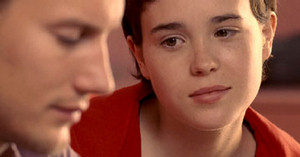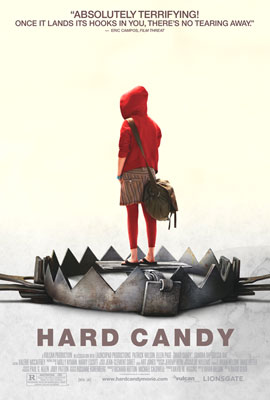The unfathomably fashionable torture film has spun off a welcome girl-power subgenre, in which determined, attractive young females facilitate the agonizing dispatches of men who have committed atrocities against youth.
In Hard Candy, a teenage girl meets a lecherous and possibly pedophilic photographer online and ends up at his house, where she aims to punish him for the sins she’s certain he’s committed. In Lady Vengeance, a young woman emerges from prison with a grudge against the man responsible for her incarceration: a serial murderer of children who forced her to confess to one of his crimes by threatening to kill her daughter.
It’s a curious but promising phenomenon – invoking Virgin Spring-style outrage and justice – and if it develops into a trend, I imagine that in its mature state it will produce a gruesome but meaningful masterpiece or two. But the early entries – these two come from 2005 – are misguided.
That’s no shock with Hard Candy, the feature debut of director David Slade. It’s a compelling conceit in search of a good script, some ambiguity, and a purpose beyond being crassly provocative. (We’ll talk about it more in a bit.)
Sadly surprising is Chan-wook Park’s Lady Vengeance, which completes the writer/director’s “Vengeance Trilogy” with a misfire. People who fell in love with his Oldboy are in for an unwelcome awakening with Lady Vengeance – the realization that Park actually can’t walk on water.
Lady Vengeance
 To say that Lady Vengeance is no Oldboy could be akin to The Squid and the Whale’s pompous father calling A Tale of Two Cities “minor Dickens”: It’s a meaningless dismissal based on standard that’s too high. But Lady Vengeance is not merely no Oldboy; it’s a failure.
To say that Lady Vengeance is no Oldboy could be akin to The Squid and the Whale’s pompous father calling A Tale of Two Cities “minor Dickens”: It’s a meaningless dismissal based on standard that’s too high. But Lady Vengeance is not merely no Oldboy; it’s a failure.
Park’s visual poetry remains intact, and the second half of the movie gracefully, patiently expresses the contradictory need for and futility of revenge. But its plot and structure are unnecessarily and distractingly ornate, and the whole film ends up confused. The director imposes a slightly less manic version of Oldboy’s unhinged tone and labyrinthine architecture on material that is fundamentally about calculation and premeditation.
The style worked so well with Oldboy because it was a reflection of the main character’s confusion, rage, and grief, but here it fights with the story, particularly considering the simplicity of the protagonist’s plan. A straightforward narrative approach – and a streamlined plot – would have invested the film with moral tension and enough room for the audience to explore its implications.
But Park – for no reason I can discern – treats it like a puzzle. Viewers are forced to work hard to make sense of the opening half, without reward. (The plot summary alone is dizzying.)
When it settles down, though, Lady Vengeance sheds its unwieldy and ugly dressing and reveals something fragile and lovely (albeit bloody). The newly freed Geum-ja Lee (Yeong-ae Lee) brings together the killer (Oldboy’s Min-sik Choi) and the families of his victims in an abandoned school. She gives them the option of turning him in to the police or delivering justice themselves. The remainder of the movie is nearly ceremonial, largely free of drama or plot. What Park had cast as a revenge thriller becomes a potent and sympathetic meditation on the toll of revenge.
The film never pretends that punishment will be satisfying to those who’ve been wronged. It finds vengeance empty and wrenching, but inexplicably and naturally necessary.
After their ordeal, Geum-ja Lee serves the families a chocolate cake in a funereal gathering that includes the incongruous singing of “Happy Birthday.” The dessert looks delicious, but it’s contrasted with a white block of tofu offered to Geum-ja upon her release from prison, a Christian’s admonition to live purely. The scene encapsulates the movie’s ambivalence toward revenge – something to be both celebrated and mourned. And the cake is a blunt but effective metaphor for the sin the families have committed – dark but irresistible.
If Park had invested the opening half of the movie with such restraint, delicacy, and sensitivity, he would have crafted a worthy successor to Oldboy.
Hard Candy
 In SAT terms, Hard Candy is to Death and the Maiden as Saw is to Se7en: a juvenile attempt to re-create the effects of a forebear without the cultural context or shading to give it any meaning or interest.
In SAT terms, Hard Candy is to Death and the Maiden as Saw is to Se7en: a juvenile attempt to re-create the effects of a forebear without the cultural context or shading to give it any meaning or interest.
The movie would hardly be worth discussing except that it’s gotten some enthusiastic reviews, and its premise is compelling enough to pique the curiosity of people who might otherwise avoid torture porn. As usual, I’m giving away too much, but it’s a cat-and-mouse game in which the roles of predator and prey are reversed.
The comparison to Death and the Maiden is apt. Roman Polanski’s 1994 movie (based on Ariel Dorfman’s play) takes place in an isolated location in which a woman interrogates and abuses the man she’s certain tortured her. Hard Candy takes place in an isolated location in which a young woman tortures a man she’s certain is a pedophile.
You’ll notice a few differences in those plot summaries, and they’re important. In Death and the Maiden, Sigourney Weaver’s middle-aged wife has endured decades of psychic pain as a result of her politically motivated incarceration – plenty of time to fantasize about her revenge, and plenty of distance to twist her memories. In Hard Candy, meanwhile, 14-year-old Hayley (Ellen Page) fancies herself as some sort of avenging angel for young girls, even though she herself gives no indication that she’s ever been abused.
The movie has no interest in Hayley’s psychology – why she’s doing what she’s doing – and it doesn’t care about the victims of abuse, either. Death and the Maiden is so effective because it never leaves the mind of its agonized protagonist; the audience is constantly aware of her rage, her pain, and the very real possibility that she’s so blinded by those that she has made a grave error. The only thing that seems to matter to Hard Candy’s filmmakers is the creative way a young woman might lure and torture a sexual predator.
It’s no surprise that the movie was scripted by a man (Brian Nelson, who has mostly written for television) and directed by a man. Men can write sensitively and accurately about women and about sexual abuse, but I doubt any woman would have approached this particular conceit with so little concern for victims.
 Slade and Nelson have a brilliant hook, and they (a
Slade and Nelson have a brilliant hook, and they (a
long with the movie’s marketers) use a Little Riding Hood visual motif to efficiently establish expectations of gender and power roles. But they don’t do anything with those (very) raw materials.
A dash of ambiguity – any ambiguity – would have helped. The ostensible villain (played by Patrick Wilson) is accused of pedophilia and murder, and the movie barely pauses to allow for the possibility of his innocence. (Wilson’s photographer, in a more thoughtful work, might be guilty of no more than creepiness, bad judgment, and an attraction to minors.) Slade and Nelson use the accusations as shorthand, though, to justify what they put him through, and there’s no room there for doubt.
The filmmakers are pandering to the audience’s thirst for justice, and ambivalence is not an effect for which they strive. They don’t want you to question what Hayley does or her motives. And they need you to cheer a young woman crafty and powerful enough to ensnare a sex offender and grab him (literally) by the balls, intent on detaching them. She’s inhuman, in the sense that she doesn’t hesitate, and that she seems undamaged by what she does. It’s not credible and belongs to the realm of fantasy.
For all its faults, Lady Vengeance at least understands that people who dispense justice – no matter how appropriate – pay a steep price. Hayley does her deed and skips down the path, whistling.


Wanna know why the Little Red Riding Hood motif wasn’t appropriately used? Because they discovered the symbolism only afterwards. The red hood was a complete coincidence, according to the DVD extras. I found that there were indeed a few simple oversights that a group of friends / focus group could have hammered out to make a better film. The way I see it, your review is all too nice of a free advice session to the writer of this film. You should charge a consulting rate. Still working on your Marnie posts huh? Mine’s up.
Squish,
If somebody’s willing to pay me to consult on a movie, I’m there.
As for “Marnie,” I’m getting tardy, aren’t I? It’s started, and I’ll let you know when it’s finished. I had the best of intentions … .